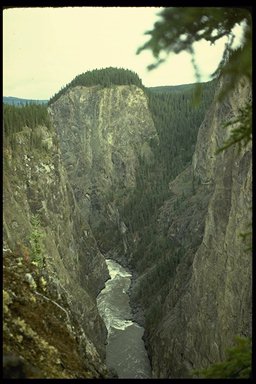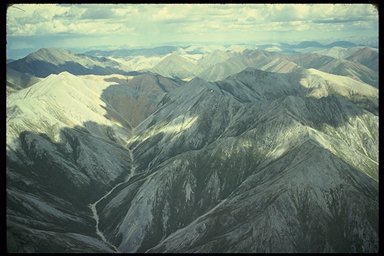
CINDER CONES, PLATEAUX AND CANYONS
... There's the land (Have you seen it?) It's the cussedest land that I know,
From the big, dizzy mountains that screen it,
To the deep, deathlike valleys below ....
from "The Spell of the Yukon", Robert W. Service

This is a large, complex region of mountains, broad plateaux, plains, basins and trenches. Glaciers and volcanoes have shaped this area extensively. The work of glaciers is present throughout, although only small icefields and glaciers exist today. A good example of active glaciers is found in the Kluane-Aiskinik area adjoining Kluane National Park Reserve. This is a rugged area where alpine glaciers have carved uplands into angular mountains and U-shaped valleys. The Yukon River-Southern Ogilvies area includes mountains over 2500 metres high with both glaciated and unglaciated mountain landscapes. Much of this area was spared from the Pleistocene glaciers, resulting in landforms that are rarely found elsewhere in Canada.

Several major rivers have carved deep canyons. The "Grand Canyon of the Stikine", where the river flows for 64 kilometres between sheer lava walls 100 metres or more in height, is one of the most spectacular river canyons in Canada. The largest lakes in British Columbia are found in this region. Mount Edziza, the apex of the Spectrum Ranges, features well-preserved examples of recent volcanic activity, including cinder cones, calderas, lava plains, dykes and other evidence of the earth's restlessness. Mt. Edziza Provincial Park includes many of these volcanic features.
VEGETATION:
Boreal forest dominates the region. Black spruce, white spruce and lodgepole pine are the most common species. Sub-alpine firs stand alone or in tight groves at the tree line. Aspen and birch paint the shorelines and lower mountain sides bright yellow in September. Broad belts of alpine tundra, lush neon-green with cow parsnip and lupines or in muted pastel shades of green, grey and rust with heather and dwarf birch, are found throughout the region at higher elevations.
WILDLIFE:
Moose, caribou, elk, Dall's and Stone's sheep, mountain goat, wolf, wolverine, black bear and grizzly bear thrive in this region. The region's many lakes and streams teem with rainbow, cutthroat and Dolly Varden trout, along with five species of salmon. The Spatsizi Plateau area is famous for its plentiful wildlife. Osborn caribou and Stone's sheep, two sub-species with limited ranges, find critical habitat in this area. Much of this area is included in Spatsizi Plateau Wilderness Provincial Park. Gladys Lake Ecological Reserve, the largest in the province (486 km2), is completely surrounded by the provincial park. It was established to conduct research on non-hunted big game species.

STATUS OF NATIONAL PARKS:
No national parks exist yet in this region. Four representative natural areas were identified in studies carried out by Parks Canada in the early 1980s: Mt. Edziza (B.C.), Spatsizi Plateau (B.C.), Kluane-Aiskinik (Yukon) and Yukon River-Southern Ogilvies (Yukon). Because new information has come to light over the past decade and the region has been impacted by human disturbances over the same period, the regional analysis work requires updating.
Several factors could affect national park establishment in this region. The hydro-electric power generating potential of the large rivers draining these areas - the Stikine, Stewart, and Yukon - is vast. Dams, reservoirs, transmission line rights-of-way and access roads would detract from the desirability of these areas for national park purposes. Big-game hunting and guiding is an important recreational and economic activity in much of the region. Forestry is increasing in the region, particularly in the lower Stikine Valley. Much of the region has mineral claims on it, and mines are under development in the Spatsizi Plateau area south of the provincial park.

Establishment of a national park in this natural region will require the support and co-operation of the native peoples and the Government of British Columbia or the Yukon Territorial Government.
The following table summarizes the status of system planning for each step toward establishing a new national park in this natural region.
| Steps in the Park Establishment Process. | Status |
| Representative Natural Areas Identified: | update required |
| Potential Park Area Selected: | 0 |
| Park Feasibility Assessed: | 0 |
| Park Agreement Signed: | 0 |
| Scheduled Under the National Parks Act: | 0 |